| Title | Pages |
|---|---|
| A Sensitive and Label-Free Electrochemical Impedance Immunosensor for CDH 22 Biomarker Detection Based on Organo-Functional Silane Modified ITO Electrode In this work, a novel electrochemical label free immunosensor was fabricated for Cadherin-like protein 22 (CDH 22) bio- marker detection based on specific immunoreaction between anti-CDH 22 antibody and CDH 22 antigen. The developed immunosensor was constructed through the immobilization of anti-CDH 22 antibodies on 3-cyanopropyltrimethoxysila- ne (CPTMS) modified ITO substrate. The effective binding of the anti-CDH 22 antibodies on the CPTMS silanization agent was investigated by using morphological characterization (Scanning Electron Microscopy (SEM), Atomic Force Microscopy (AFM)) and electrochemical characterization (Electrochemical Impedance Spectroscopy (EIS), Cyclic Voltammetry (CV)). Under optimum experimental conditions, the ITO/CPTMS modified electrode was a good linker for anti-CDH 22 antibody anchoring. In addition, CPTMS modified electrode offered an efficient surface to CDH 22 antigen detection. The immuno- sensor had a wide linear detection range (0.03-3 pg/mL) with low detection limit (9 fg/mL). Also, it had good reproducibility, excellent repeatability and long storage stability. In addition, the practical applicability of the proposed immunosensor was investigated by utilizing human serum samples. The human serum samples recovery results (99.16% - 101.94%) illustrated the accuracy of the suggested biosensor. Consequently, CPTMS can be a promising platform for biosensor construction and this suggested immunosensor can be applicable for real human serum analysis. 



|
327 - 337 |
| Plasmonic Zr-Based Metal–Organic Frameworks for Accelerated De-Colorization of Methylene Blue Under LED Light Irradiation Well-defined photocatalyst with 3D morphologies have attracted the attention of scientists due to the more accessible reactive surfaces, easy to recover from reaction medium, and low aggregation. Within this scope, photocatalysis based on plasmonic metal-organic frameworks (MOFs) were synthesized and utilized as an alternative reactive platform for visible-light degradation of methylene blue (MB) under green LED irradiation for the first time. In order to reduce the recombination between electron-hole pairs, a stable oxidant, namely sodium persulfate (PS) was employed to accelerate the photocatalytic decolorization of MB. These feasible strategies demonstrated that a bleaching degree of 91% (i.e., in the presence of PS) within 120 min was achieved compared to the bare Au@UiO-66@Pdop NPs (bleaching degree 31%). The obtained results from this study highlighted the superior properties of the newly synthesized core-shell Au@UiO-66@Pdop photocatalysts and clearly declared the great potential of the photo-responsive MOFs for organic pollutant degradations as well. 

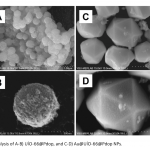

|
339 - 346 |
| Assessment of The Spatio-Temporal Distribution and Habitat Preferences of Ostracoda (Crustacea) Related to Certain Environmental Factors in Kapıdağ Peninsula (The Sea of Marmara, Turkey) The Sea of Marmara is exposed to pollutants in excess from the coastal industrial facilities and intensive urbanization, and because of that, the ecosystem is affected negatively. The aim of this study was to determine the environmental factors and ecological parameters on the species distribution and abundance of Ostracoda in Kapıdağ Peninsula coastline. At four seasons (April, July, October 2011 and January 2012), samples were collected from 21 stations (total of 84 samples) and 36 Ostracoda species were identified. The most distributed ostracod species were Carinocythereis antiquata, Aurila convexa, Loxoconcha gibberosa, Paradoxostoma fuscum, Cushmanidea elongata, and Xestoleberis decipiens. The highest numbers of individuals observed were Loxoconcha rhomboidea and Xestoleberis aurantia. During the study, water temperature varied between 7.5 and 30°C, salinity varied between 12.1 and 29.2‰, pH varied between 6.6 and 8.7, and dissolved oxygen varied between 1.2 and 15.3 mgL-1 in the stations across the four seasons. Depth, mud percentage and the transparency of the water were the most effective factors on the living ostracod species of Kapıdağ Peninsula coastline according to spearman correlations. 

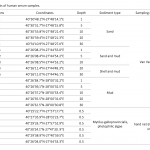

|
347 - 365 |
| Biosynthesis of Gold Nanoparticles using Scytosiphon lomentaria (Brown algae) and Spyridia filamentosa (Red algae) from Kyrenia Region and Evaluation of their Antimicrobial and Antioxidant Activity This study was carried out for biosynthesis of gold nanoparticles by using Scytosiphon lomentaria (brown algae) and Spyridia filamentosa (red algae) and compared. Synthesized gold nanoparticles were characterized using the UV-Vis spectroscopy (UV-Vis), Fourier transform infrared (FTIR) and Master Sizer analysis. Macro algae extract involvement in the stabilization of the gold nanoparticles was confirmed by the presence of UV-Vis peak at 540 nm and is an indication of the presence of the gold nanoparticles (AuNPs). Strech in peaks of the FTIR showed that the biomolecules present in the seaweed extract reduced the gold ions. Master sizer results for AuNPs were within the range of 15-55 nm. Antioxidant activity carried out using 2,2-diphenyl-1-picrylhydrazyl (DPPH) free radical scavenging activity revealed significant activity for both AuNPs. Biosynthesized AuNPs also showed antimicrobial activity against S. typhii and E. coli. The S. lomentaria AuNPs exhibited inhibition against E. coli, whereas S. filamentosa gold nanoparticles showed antibacterial activity against S. typhi. Synthesized AuNPs using S. lomentaria and S. filamentosa extracts as stabilizing agents showed convincing antioxidant and antimicrobial activity against gram negative and gram positive bacteria. 

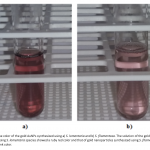

|
367 - 382 |
| Exosome Production, Isolation and Characterization from A549 Epithelial Carcinoma Cells Exosomes are natural nanoparticles that their special features as a natural, homogeneous, nanosized, targeted vesicles (~ 50- 100 nm) have started to be used in the treatment of cancer very recently They have high avidity (many conformational attach- ment) to attach onto targeted cancer cell surfaces. They are composed of bioactive double-layered lipid layers in which their ori- ginal nature has the adhesive proteins interacting with the cancer cell membrane easily. In this study, the exosomes of non-small cell lung cancer, A549-epithelial carcinoma cells were investigated for their potential to be the natural or synthetic drug carrier. Firstly, exosomes of A549 cell line were produced using exosome-free media. Immediately after, isolation of their exosomes were performed by using ultracentrifugation procedure. Their SEM image, particle size and zeta potential measurements, exosomal RNA analysis and Protein Content by Bradford assays were performed. Findings (Size: 168 nm; zeta: -16mV) on the properties of A549 cell exosomes proved their potential to be used as the drug carrier for cancer cell therapy. 


|
383 - 388 |
| Comparative Anatomical Survey on the species of Iberis L. (Brassicaceae) from Turkey Iberis taxa natively found in Turkey are represented by eight species and are annual and/or perennial herbs or subshrubs. In this study, we provide a detailed anatomical description of Turkish Iberis taxa for the first time and try to solve the complexity of taxonomical uncertainties of the genus. Root, stem and leaf anatomies are investigated and stomatal index of Iberis is indicated. Our results provided valuable evidence on the doubtful circumstance of species in this genus. I. attica is the only species that has winged stem structure and branched trichomes. I. carica, one of the endemics, is the only species with its continuous vascular cambium in stem that forms a vascular bundle circle. I. sempervirens is the only species without indumentum which has also a subshrub habit. I. odorata is the only annual species. There are two types of leaf anatomy as bilateral and isolateral. Turkish Iberis taxa show amphistomatic leaves. Myrosin cells that are the characteristic of the order Brassicales are observed in all examined species. Anatomical results support that I. attica and I. spruneri are two separate taxa instead of as combined I. carnosa. 



|
389 - 401 |
| Determination of Biochemical Profile of Bilecik Propolis Propolis, an important bee product, is used as a food supplement in apitherapy applications and daily life due to its antioxidant, antimicrobial, antitumoral and anti-inflammatory properties. The properties of propolis vary depending on the region in which it is obtained, the time and the form of collection. It is not possible to obtain propolis with the same characteristics from each hive or region. In this study, raw propolis samples were obtained from Bilecik province in Marmara Region and their biochemical properties were determined. Bilecik is rich in forestry covered with oak, beech, fir, linden and chestnut trees. Therefore, it has a rich flora. In order to determine the properties of propolis samples, ethanol extract of each sample was prepared separately by using 70% ethanol. The amount of balsam, wax, total phenolics and total flavonoid of each sample was determined. Chemical composition of each propolis sample was determined by using GC-MS. The amount of balsam which is an important quality parameter for propolis was found to vary between 13% and 52%. It was also found that total phenolic content ranged from 11 mg GAE / mL to 76 mg GAE / mL. It is determined that propolis samples were rich in aldehydes, aliphatic acid and esters, alcohols, hydrocarbons, carboxylic acid esters, ketones, terpenes, fatty acids and other components. 

|
403 - 409 |
| The Effect of Interval Training Program on Nuclear Factor Erythroid-Derived 2-like 2 (NFE2L2/Nrf2) Gene Expression in Women Purpose in this work, to investigate whether interval training program has an effect on Nuclear factor erythroid-derived 2-like 2 (NFE2L2/Nrf2) gene expression in women.The research was made on 12 women. Participants were given a medium-term interval training program for 8 weeks, 3 days a week. The blood samples of the participants were collected before and after the 8 weeks of training. RNA isolation was performed using TRIzol Reagent from peripheral blood mononuclear cells. NFE2L2 gene expression was determined by Biomark Real-Time PCR (RT-PCR). The participants was a significant increase in heart rate and maximal oxygen use capacity (VO2 max ) after the exercise (p <0.001). There was a significant decrease in the body weight and body mass index of women after the exercise (p <0.001). There was a decrease in NFE2L2 gene expressions after 8 weeks of the training program (p <0.05,). It shows that interval exercise reduces NFE2L2 gene expression in women. 

|
411 - 415 |
| Facile Synthesis of Two Azete-Steroid Derivatives and Theoretical Evaluation of Its Interaction with the Aromatase Enzyme Several aromatase inhibitors have used for the treatment of breast cancer; however, some of these drugs may produce some side effects such as endometrial cancer and bone loss. The aim of this study was to synthesize two new azete-steroid derivatives (compounds 9 or 10) to evaluate its theoretical interaction with an aromatase enzyme (2wd3) using anastrozole and exemestane as controls in a docking model. The preparation of 9 and 10 was carried out using a series of reactions which involves amination, etherification, nitration, and addition. Chemical structure of the compounds was confirmed using elemental analysis and NMR spectrum. The results showed that compounds 9 or 10 could bind to a different type of aminoacid residues involved in of 2wd3 protein surface compared anastrozole and exemestane; this phenomenon may exert changes in the biological activity of aromatase enzyme. All data suggest that compounds 9 or 10 could be an alternative for the treatment of breast cancer; therefore it could be a good candidate for the pharmaceutical industry. 



|
417 - 430 |
| Chemical Taxonomy Applications of Some Water Mite Species (Acari, Hydrachnidia) Using Fourier Transform Infrared Spectroscopy (FTIR) Methods This study employed water mite (Acari, Hydrachnidia) species collected from a natural lake water environment. These species included Hydrodroma despiciens, Eylais infundibulifera, Hydryphantes flexiosus, Georgella helvatica, Hygrobates nigromacutlatus, Hydryphantes thoni ve Torrenticola bevirostris. Chemical analyses of these species were conducted using the Fourier infrared spectrophotometer (FTIR) technique. Solid phase IR spectra were made individually for each species. The data obtained for all species were examined graphically and were identified in four different spectral regions. Finally, the spectrum frequency ranges of these species were determined. The functional groups OH, C-H, C=O, C-O, and C-N were observed. The vibrational frequencies of each species studied were determined. When evaluating the results of the spectroscopic analysis, the range of the spectrum of these species was shown to be similar to one another; however, peak intervals were different for each species. 

|
431 - 435 |
| Practical Synthesis of Pyrido [1,2-A] Benzimidazoles Via Multicomponent Reactions Afacile and efficient synthesis of 1-amino-3-(4-substituted)-4-nitro-3,5-dihydrobenzo[4,5]imidazo[1,2-a]pyridine-2-carbonitriles was conducted via one-pot multicomponent reaction of 2-(nitromethylene)-2,3-dihydro-1H-benzo[d]imi-dazole withmalononitrile and aromatic aldehydes. Besides, no tedious work-up procedure was necessary for the isolation of desired products which were precipitated out of reaction medium in pure state. Ten new title compounds were characterized by the means of physical and spectroscopic methods (m.p., IR, NMR and TOF-MS analyses). 



|
437 - 444 |
| Modified Graphite Surfaces Prepared for Electrochemical Biomolecular Interaction Detection Studies This paper demonstrates the fabrication of electroactive polymer modified electrode materials for monitoring biomolecular interactions between double-stranded DNA (dsDNA) and Mitomycin C (MMC) which is an important and commonly used anticancer drug. The modified electrode materials were constructed by the electropolymerization of o-phenylenediamine (oPD) monomer in a solution containing nanomaterial as well. The nanomaterial used as the dopant molecule was graphene (GN) and the electropolymerization technique was cyclic voltammetry (CV). Subsequently immobilization of dsDNA was achieved onto poly(o-phenylenediamine) (PoPD) polymer modified surfaces. So-formed dsDNA immobilized nanomaterial incorporated polymer modified electrodes were used as the biosensing platforms for the detection of dsDNA-MMC interaction. Different MMC interaction times were studied in order to identify biomolecular interactions. 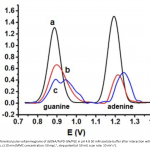

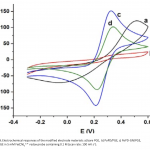

|
445 - 454 |